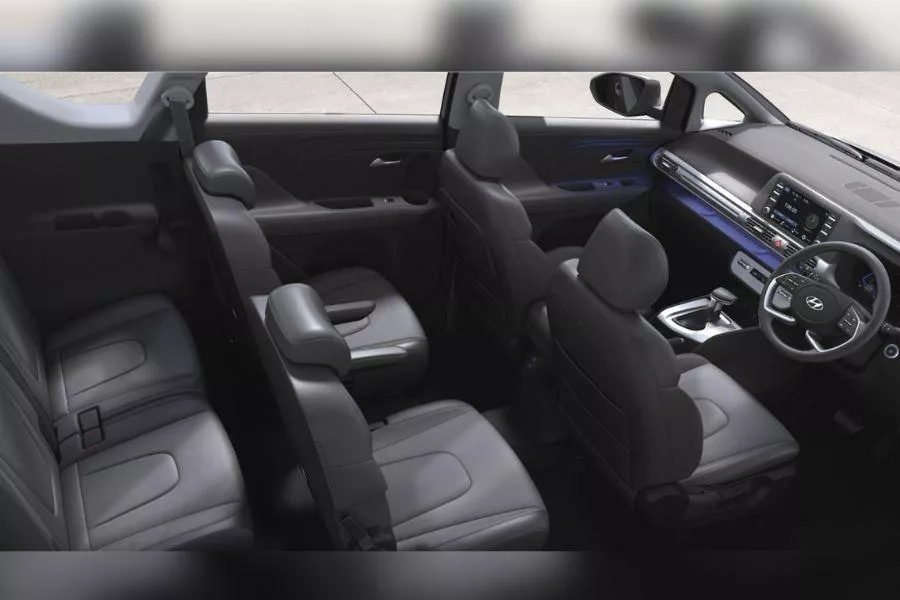Hyundai has fully revealed its Stargazer MPV for the Indonesian market, and it is shaping up to be a worthy contender in the segment. The South Korean automaker has plans of going up against more established nameplates, one of which is the Xpander, also manufactured in Indonesia by Hyundai’s Japanese rival Mitsubishi.

There's a new player in Indonesia's MPV segment in the form of the Hyundai Stargazer
“Stargazer is designed with the feel of a spacious cabin and maximum space utilization while prioritizing comfort. This product is specially designed as a new benchmark in its class,” said PT Hyundai Motors Indonesia President Director Woojune Cha. “Stargazer can be a comfortable, practical family choice vehicle for daily mobility needs on long trips.
Let’s take a look at how Hyundai’s latest offering for the ASEAN market stacks up against one of the MPV segment’s favorites.
Exterior
Dimensions for the Stargazer comprise 4,460mm in length, 1,780mm in width, and 1,695mm in height. These make it 135mm shorter and 55mm lower than the Xpander, although the Stargazer measures 30mm wider. Hyundai’s entry even tops the Xpander’s 2,775mm wheelbase by an additional 5mm.

There seems to be a common design theme among vehicle of this class
Both models utilize a two-box design for the body, with the passenger and cargo areas combined into a single compartment distinct from the engine bay. There’s a faint similarity between the Xpander’s Dynamic Shield fascia and the Stargazer’s rendition, although the latter takes its visual cues from its larger Staria corporate sibling.
The Stargazer features a shorter hood than the Xpander, terminating in a full-width horizontal DRL just above the H emblem. Down below, the Stargazer’s LED headlamps are arranged in a square layout, in contrast with the Xpander’s T-shaped design.

The Stargazer's rear has a distinctive light signature
Similar to the Xpander, the Stargazer features a rising beltline from the A-pillar accompanied by a prominent crease along the profile. Where the Xpander uses L-shaped tail lamps, the Stargazer adopts an H-shaped motif, resulting in a striking light signature. The Hyundai also sports wheels between 15 and 16 inches, compared to the standard 17-inch alloys on the Mitsubishi.
Interior
Inside, the Stargazer features an airy-looking interior just like its Japanese-branded counterpart. However, one notable detail is the use of captain’s chairs on the second row for top-tier variants, complete with armrests. This frees up a corridor in the middle that is not possible with the Xpander’s second-row bench.

Hyundai is offering its MPV in both 6- and 7-seater versions
Another area where the Stargazer bests the Xpander is in the number of onboard amenities. On top of the cupholders, door pockets, and storage nooks offered on the Xpander, the Stargazer comes with seatback trays and integrated picnic tables.
Tech & Safety
Hyundai seemingly made sure that the Stargazer would be a veritable tech showcase in its segment. The 4.2-inch TFT cluster display on the instrument panel comes with a tire pressure monitoring system.

The touchscreen display features Hyundai's Bluelink connected service
Both the Xpander and Stargazer come with a touchscreen dashboard monitor, the latter featuring Hyundai’s Bluelink connected car service that enables smartphone linking, remote engine start, and vehicle locating capability. In addition to USB ports and a 12-volt power socket, the Stargazer is available with wireless smartphone charging, another feature missing on the Xpander.
Mitsubishi has endowed the Xpander with a decent safety loadout comprising dual airbags, seven seatbelts, anti-lock brakes, stability control, and hill-start assist. However, Hyundai has a leg up on the competition with its Smartsense suite of driver-assist features such as Forward Collision-Avoidance Assist, Lane Keeping Assist, and Blind-spot Collision Warning.
Engine & Drivetrain
For propulsion, the Stargazer relies on a 1.5-liter Smartstream gasoline engine with multi-point injection, similar to the power unit used on the Xpander. However, the Stargazer has a higher power output at 113 horsepower against the Xpander’s 104. Torque ratings are also in the Stargazer’s favor at 144 Nm compared to the Xpander’s 141.

Driver-assist features are part of the Stargazer's onboard equipment
Both the Stargazer and Xpander offer a 6-speed manual as the base transmission. But while the Xpander also comes with a 4-speed torque converter automatic, the Stargazer’s alternative is Hyundai’s Intelligent Variable Transmission (IVT). A front-wheel drivetrain is standard on both models.
Price
For the Indonesian market, the Hyundai Stargazer is offered in six trim levels, ranging from IDR 243,300,000 (around Php 915,000) to IDR 307,100,000 (Php 1,155,000). These are significantly lower than the Mitsubishi Xpander’s current Philippine prices ranging from Php 1,050,000 to Php 1,180,000, although the Stargazer’s rates are exclusive of taxes and other fees.
If the Hyundai Stargazer were to be released here, expect its competitor MPVs to be on their toes. Do you think Hyundai Motor Philippines can make it happen?
Keep an eye out for new models released whether here or abroad at Philkotse.com.
Recent posts
- hyundai philippines new model lineup finalize june Aug 30, 2022
- 2023 mitsubishi xpander philippine debut Jun 17, 2022
- Hyundai Staria Red Dot Award Mar 30, 2022
- xpander l300 lead mmpc sales 2021 Feb 24, 2022
















